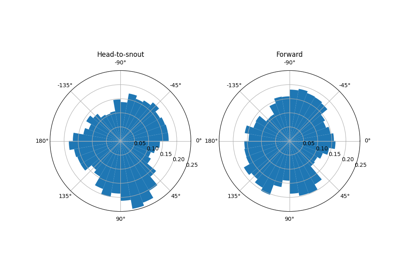compute_forward_vector_angle#
- movement.kinematics.compute_forward_vector_angle(data, left_keypoint, right_keypoint, reference_vector=(1, 0), camera_view='top_down', in_degrees=False)[source]#
Compute the signed angle between a reference and a forward vector.
Forward vector angle is the
signed anglebetween the reference vector and the animal’sforward vector. The returned angles are in radians, spanning the range \((-\pi, \pi]\), unlessin_degreesis set toTrue.- Parameters:
data (xarray.DataArray) – The input data representing position. This must contain the two symmetrical keypoints located on the left and right sides of the body, respectively.
left_keypoint (Hashable) – Name of the left keypoint, e.g., “left_ear”, used to compute the forward vector.
right_keypoint (Hashable) – Name of the right keypoint, e.g., “right_ear”, used to compute the forward vector.
reference_vector (xr.DataArray | ArrayLike, optional) – The reference vector against which the
forward_vectoris compared to compute 2D heading. Must be a two-dimensional vector, in the form [x,y] - wherereference_vector[0]corresponds to the x-coordinate andreference_vector[1]corresponds to the y-coordinate. If left unspecified, the vector [1, 0] is used by default.camera_view (Literal["top_down", "bottom_up"], optional) – The camera viewing angle, used to determine the upwards direction of the animal. Can be either
"top_down"(where the upwards direction is [0, 0, -1]), or"bottom_up"(where the upwards direction is [0, 0, 1]). If left unspecified, the camera view is assumed to be"top_down".in_degrees (bool) – If
True, the returned heading array is given in degrees. Otherwise, the array is given in radians. DefaultFalse.
- Returns:
An xarray DataArray containing the computed forward vector angles, with dimensions matching the input data array, but without the
keypointsandspacedimensions.- Return type:
See also
movement.utils.vector.compute_signed_angle_2dThe underlying function used to compute the signed angle between two 2D vectors. See this function for a definition of the signed angle between two vectors.
movement.kinematics.compute_forward_vectorThe function used to compute the forward vector.
